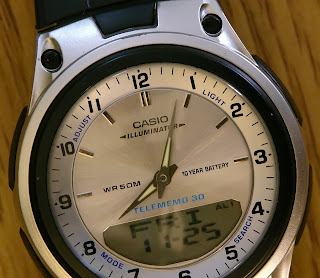I have way, way too much stuff. Most of it is books. Then there's my calculators, watches, cameras, and various computer things. But then there are things that I have no idea why I have them, what they're good for, or where to put them. This is where the Theory of Awesomeness comes into its own.
Before, during and after the big move, I've had to make a seemingly endless series of decisions about what to keep, what to give to the Salvos*, and what to send to the Tip*. My Theory of Awesomeness makes these decisions vastly easier and in many cases so obvious that I don't know what I'd do without it. It's Awesome.
That's actually one way to define Awesomeness: the degree to which something is Awesome. But to avoid a tautology (look it up), Scientists are trained to define concepts like this quantitatively. Therefore,
where a0 is the baseline Awesomeness, U(t) is the item's usefulness or un-usefulness as a function of time, E(t) is the Elegance (or lack thereof) which is defined as the base-pi logarithm of the coolness, and d is the density. Obviously things that are Awesome because of rather than in spite of how much space they take up or how much they cost will require a different equation.
The real power of this equation is that it will be at least a week before someone emails me and says, "Hey, wait a minute . . . ."
While packing for the big move, each item's Awesomeness was calculated. If it was less than the baseline Awesomeness, I threw it away. If it was merely baseline Awesomeness, I gave it away. If an item was clearly and demonstrably Awesome, I kept it. For example, there were some books containing information that was irrelevant even when new, but which was now also out of date. These were tossed straight in the bin. Items of clothing for which the Awesomeness had worn out leaving large holes in them were also thrown out unless they could be used as awesome paint rags.
 None of my calculators got thrown away or given away, owing to the fact that even the broken ones take up so little space and were in past times (t approaching negative infinity) very useful. Most of the books I own stayed because they have potential usefulness as t approaches infinity. All of my watches and clocks were saved from the axe due to their undiminishing elegance and/or coolness.
None of my calculators got thrown away or given away, owing to the fact that even the broken ones take up so little space and were in past times (t approaching negative infinity) very useful. Most of the books I own stayed because they have potential usefulness as t approaches infinity. All of my watches and clocks were saved from the axe due to their undiminishing elegance and/or coolness.Highly subjective, you say? I don't think so. I defy anyone to prove that this incredibly practical Casio with a 10-year battery
Or try to prove that this limited-edition watch isn't the coolest thing in the entire Solar System. The face revolves once per sidereal day and correctly displays the location in the southern hemisphere of 1000 celestial objects at any given time. As the months pass and the earth revolves around the sun, the dial keeps track of the changes in the night sky and shows me which constellations and stars are visible at the moment. That is, as long as I have the 10x magnifier that came with it. Sometimes I wear it even if I'm not particularly fussed about what stars are presently visible. It's the sort of watch that a great wizard like Dumbledore would have worn on a daily basis. Heck, it's the sort of watch Dumbledore would have invented.
Or, prove that this Seiko Chronograph
Well, I couldn't have expected anyone else to realize that I needed a watch with a rotary logarithmic slide rule. Oh, sure, it's completely obvious in hindsight. But my understanding of the Theory of Awesomeness makes buying my own birthday presents the most practical and scientifically sound course of action.
So, the next time you have to make a decision about what to keep, what to throw away, what to donate, or what to buy that special engineer or scientist in your life for Newtonmas (only 30 shopping days left!), feel free to use my Theory of Awesomeness. If an item contains enough Awesomeness, it is worth having. It might even be worth the trouble of moving it to another house.
* Salvos is Australian slang for The Salvation Army, which in addition to being among Australia's many excellent religious organizations, operates an immensely useful chain of thrift stores.
* The Tip is the Australian word for a landfill.




So "stuff" has the units of liter dollars per year?
ReplyDeleteYou've heard that "time is money?" Well, not quite. Time is actually money over length cubed, or dollars per cubic meter. The term t*pi*d/$ has dimensions of radians.
ReplyDelete... actually, that makes Money equal to all four dimensions of Space-Time!!!! I think that's a publishable result.
ReplyDeletewhere can I get the solar system watch?
ReplyDeleteThe Astrodea watch displays the fixed stars (not the solar system -e.g. the planets - but wouldn't THAT be awesome as well.)
DeleteFor the Northern Hemisphere you can get them through amazon, e.g. the link below. For Southern Hemisphere, I got mine directly from Citizen in Japan which makes them on a limited basis.
http://www.amazon.com/gp/product/B00HS8OJGI/ref=as_li_ss_tl?ie=UTF8&camp=1789&creative=390957&creativeASIN=B00HS8OJGI&linkCode=as2&tag=wwwsmartinven-20